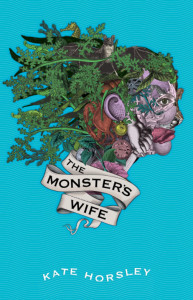'She would be pure, every scrap of impiety gone, no longer a monster but a girl made from glass, a prism catching the scant rays of the evening sun.'
The name Frankenstein conjures up an image of the booted and bolted celluloid monster with its drunken gait and toddler-like curiosity. Mute and massive he's an unpredictable tour de force destined to bring about the end of civilization. The monster's star has, of course, out-shone that of his maker, the real Frankenstein, thanks to James Whale's widely-lauded cinematic offerings Frankenstein and Bride of Frankenstein. But Whale's artistic license gave his monster a dumb, almost-comical presence, a far cry from Shelley's fearful, intelligent creature able to negotiate and manipulate to get his own way.
And what of his electric-haired bride, beautiful and doomed to be on the cover of many horror anthologies to come? In Shelley's novel she was hacked to pieces by her maker before being given that final spark of life. The author gave the creature a voice but gave his bride nothing. It is only now that she is given her own story, in the pages of Horsley's decadent, historical novel The Monster's Wife.
When Shelley wrote Frankenstein or The Modern Prometheus, she took the doctor to the Orkneys, a set of islands off the north coast of Scotland. Here he could be left, uninterrupted, to seek out the unformed clay with which to make his bride. And it is here that The Monster's Wife is set, on the island of Hoy, where that clay once took the form of a girl, a woman, as strong and fearless as any man.
'Though Oona was as used to dressing game as the next girl, the sight of the doe's guts pinned out across the board made her wince.'
This is not a sequel. Neither is it a story of a life before the doctor and his creature. Rather, it is a narrative that runs alongside the original, taking what is almost an after-thought and giving it a conscience. It is a story about friendship, courage and identity in a hostile climate. These are an uneducated people adept at deboning fish and slaughtering animals but ignorant of life beyond the island. Reliant on the sea for their livelihood, they live both in fear and in awe of her power. There are hints in fireside tales of what lies beneath, and sometimes the horrors that dwell in the darkness are brought forth to the beaches to litter the rocks.
'Course grass swathed the roof and huddled in clumps around the doorway. The midden spreading out in front of the shack was strewn with starfish and the clenched lips of razor clams. A grey cat rootling in the muck dug out a fish head and started licking it.'
But the sea is more than a malevolent deity and its tempestuous nature is shared with the novel's heroine, Oona, and her close friend May. The bond they share arouses suspicion among the locals, who fear a witchy threat to their manly prowess. A woman should be attentive and loyal to her man, so these two wild, wilful women who do as they please are perfect fodder for the rumour-mongers. Not least when Dr Frankenstein appears and their lives become inextricably entwined with his.
'The night he landed, a storm rose and blew boats towards the Northern ice floes… new lambs were stolen and hens found with their throats torn out. Kirk-going women left their cooking and ran wild, reeling home soused to take the distaff to their husbands' heads.'
His foreignness, his prestige and charm draw the girls in to his world. Here is a mystery to be solved. There is fear, but there is also intrigue. Desire stirs, blood flows hot and there is a crackle of electricity in the air. It is a warm comfort compared to the sparse, cold life on the island, which Horsley describes wonderfully.
'Most there had risen in darkness to break the ice-lid on the ewer's cold bone, to dress in stiff clothes unpacked from chests stuffed with camphor and lavender. They had settled old bones, sick bones, fidgety children on hard pews full of the night's damps. And now the bride was late.'
As the plot unfolds we get an insight into island life. Horsley travelled to Hoy whilst researching the book and clearly brought back a wealth of knowledge and sentiment. It is a brave move to write a historical novel, though easier, I expect, if much of the land has remained unchanged for years. The topography and landscape are significant, pushing the novel along through the twists and turns of a rugged terrain, and there is a twang to her characters' diction, while her use of words such as pandybats, bannocks, laird and sadiron give the novel an authentic feel.
'Oona fancied that the three long days and nights Jonah spent in the belly of the whale were neither as dark nor as foul as her week had been.'
It is easy to see why, not long after its publication, The Monster's Wife was nominated for the Saltire Scottish First Book of The Year Award. For all its historic and geographic authenticity, Horsley's novel is a nod to neo romanticism. Here is an author who loves the cadence of the English language...
'The words were still there, buried under layers, pushing pale and waxy horns of raw growth towards the light.'
...and the result is a moving tale with touches of beautifully-described horror nestled in the historical back-drop of a questionably malevolent island.




